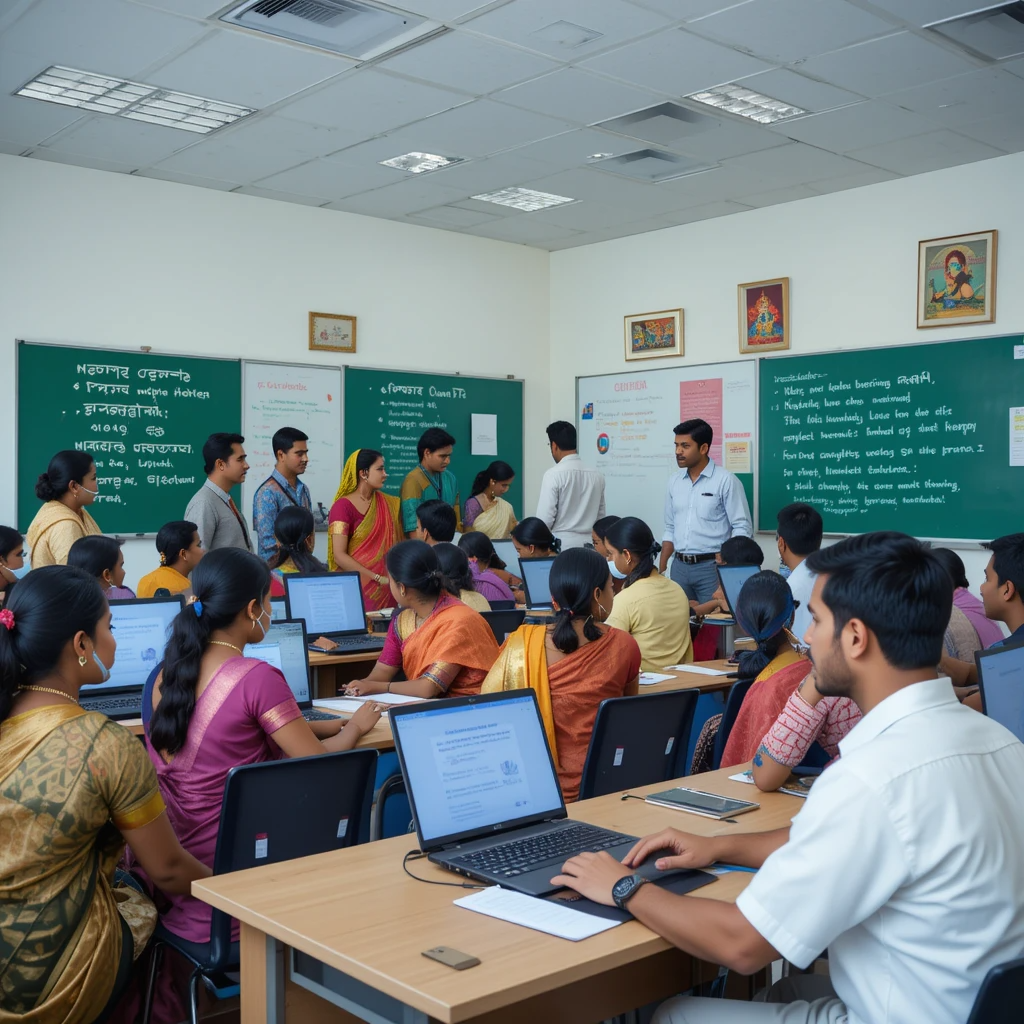In an era where technology shapes every aspect of our lives, the preservation and promotion of regional languages and cultures face unprecedented challenges. However, in Karnataka, a remarkable movement has emerged that not only embraces technological advancement but also celebrates linguistic heritage. This movement is embodied in the concept of CyberKannadig—a fusion of digital innovation and Kannada cultural identity that is transforming how technology intersects with tradition in India’s Silicon Valley.
Understanding the CyberKannadig Phenomenon
The term CyberKannadig represents more than just a technological trend; it embodies a cultural revolution. At its core, CyberKannadig refers to the integration of cyber technology with Kannada culture, creating an inclusive digital ecosystem that empowers Kannada speakers while preserving their linguistic and cultural heritage. This concept has evolved from a simple idea into a comprehensive movement that spans education, entrepreneurship, content creation, and community building.
CyberKannadig is fundamentally about democratizing technology access for Kannada speakers. In a digital landscape predominantly dominated by English content, this initiative ensures that language barriers don’t prevent people from participating in the technological revolution. It’s a movement that recognizes the importance of cultural identity in the digital age while simultaneously embracing innovation and progress.
The emergence of CyberKannadig reflects a broader understanding that technology should be inclusive and culturally sensitive. Rather than forcing communities to abandon their linguistic heritage to participate in the digital economy, this approach demonstrates how technology can be adapted to serve diverse cultural needs while maintaining authenticity and relevance.
Digital Literacy Revolution in Kannada
One of the most significant contributions of the CyberKannadig movement is its focus on digital literacy education delivered in the Kannada language. This approach has revolutionized how technology education is perceived and accessed in Karnataka, particularly in rural areas where English proficiency may be limited.

The digital literacy initiatives under CyberKannadig cover a comprehensive range of topics essential for modern life. From basic computer skills and internet navigation to advanced concepts like cybersecurity and digital privacy, these programs ensure that Kannada speakers can confidently navigate the digital world. The curriculum includes practical applications such as understanding government digital services like DigiLocker and UPI, which are crucial for everyday transactions and official procedures.
What makes this approach particularly effective is its cultural relevance. By delivering technical concepts in Kannada, educators can use familiar analogies, cultural references, and local examples that resonate with learners. This method not only improves comprehension but also increases engagement and retention among participants.
The impact of these digital literacy programs extends beyond individual skill development. Communities that have participated in CyberKannadig initiatives report increased confidence in using technology, better access to government services, and improved economic opportunities. Small business owners, for instance, have learned to leverage digital marketing tools, while farmers have gained access to weather forecasting apps and agricultural information systems.
Entrepreneurial Innovation and Startup Ecosystem
The CyberKannadig movement has significantly influenced Karnataka’s startup ecosystem, fostering a new generation of entrepreneurs who seamlessly blend technological innovation with cultural awareness. These entrepreneurs are not merely following global trends; they are creating solutions that address specific needs within the Kannada-speaking community while maintaining global relevance.
Notable success stories have emerged from this ecosystem, with entrepreneurs developing applications and platforms that cater specifically to Kannada users. These range from language learning apps that help diaspora communities maintain their connection to Kannada culture, to e-commerce platforms that support local artisans and traditional crafts. The success of companies like Zerodha, founded by Nithin Kamath, demonstrates how CyberKannadig entrepreneurs can build globally successful businesses while maintaining strong roots in their cultural heritage.
The startup scene has also benefited from the collaborative spirit inherent in the CyberKannadig movement. Tech meetups, hackathons, and coding challenges focused on Kannada language processing and cultural applications have become regular features of Karnataka’s innovation landscape. These events bring together developers, designers, and entrepreneurs who share a common vision of technology that serves cultural preservation and community empowerment.
Investment patterns have also shifted to recognize the potential of culturally-aware technology solutions. Venture capitalists and angel investors are increasingly interested in startups that demonstrate deep understanding of local markets and cultural nuances, recognizing that such companies often have sustainable competitive advantages and strong community support.
Content Creation and Digital Storytelling
The digital content landscape in Karnataka has been transformed by CyberKannadig creators who are redefining how regional stories are told and shared online. These content creators are not just translating global content into Kannada; they are creating original, culturally relevant content that reflects the unique perspectives and experiences of Kannada speakers.
YouTube channels, blogs, and social media platforms have become powerful vehicles for Kannada content creation. From comedy sketches that incorporate local humor and cultural references to educational videos that explain complex topics in accessible Kannada, these creators are building substantial audiences both within Karnataka and among the global Kannada diaspora.
The impact of this content creation extends beyond entertainment. Educational content creators are making subjects like science, technology, and mathematics accessible to Kannada speakers who might struggle with English-medium instruction. This has democratized learning opportunities and created pathways for academic and professional advancement that were previously limited by language barriers.
Influencers and content creators have also played a crucial role in promoting digital literacy and safe online practices. Through their platforms, they educate audiences about cybersecurity, digital privacy, and responsible social media use, contributing to a more informed and secure digital community.
Technological Infrastructure and Innovation
The CyberKannadig movement has driven significant innovations in language technology and digital infrastructure. Open-source projects have been instrumental in this development, with contributors creating tools that enable Kannada typing, text processing, and digital communication.

Projects like Baraha and Nudi have revolutionized Kannada computing by providing reliable input methods for digital devices. These tools have made it possible for Kannada speakers to create documents, send emails, and engage in social media using their native script, removing a significant barrier to digital participation.
Machine learning and artificial intelligence applications have also benefited from CyberKannadig innovations. Natural language processing tools for Kannada have improved significantly, enabling better translation services, voice recognition systems, and automated content generation. These technological advances have practical applications in customer service, education, and accessibility tools for users with disabilities.
The development of Kannada-specific mobile applications has created a thriving ecosystem of digital tools tailored to local needs. From news aggregation apps that curate content from Kannada sources to shopping platforms that support local businesses, these applications demonstrate how technology can be adapted to serve specific cultural and linguistic communities.
Educational Transformation and Knowledge Sharing
Educational institutions across Karnataka have embraced the CyberKannadig philosophy, integrating technology education with cultural preservation. Schools and colleges are developing curricula that teach programming and digital skills using Kannada as the medium of instruction, making these subjects more accessible to students from diverse backgrounds.
Online learning platforms have emerged that specifically cater to Kannada speakers, offering courses in everything from basic computer literacy to advanced programming languages. These platforms often incorporate gamification elements and cultural references that make learning more engaging and relevant for Kannada students.
The knowledge sharing aspect of CyberKannadig has created informal learning networks where experienced professionals mentor newcomers, sharing both technical knowledge and cultural wisdom. These mentorship programs have been particularly effective in encouraging young people to pursue careers in technology while maintaining their cultural identity.
Research and development initiatives have also benefited from the CyberKannadig approach. Academic institutions are conducting research on Kannada language processing, cultural digitization, and technology adoption patterns within regional communities. This research contributes to both technological advancement and cultural preservation efforts.
Challenges and Future Opportunities
Despite its successes, the CyberKannadig movement faces several challenges that require ongoing attention and innovative solutions. The digital divide remains a significant issue, particularly in rural areas where internet connectivity and device access are limited. Addressing this challenge requires coordinated efforts between government, private sector, and community organizations.
Language standardization in digital formats presents another challenge. While Kannada has a rich literary tradition, adapting the language for digital communication requires consistent standards for spelling, grammar, and technical terminology. The CyberKannadig community is working to develop these standards while preserving the language’s natural evolution and regional variations.
Cultural resistance to digital adoption, particularly among older generations, requires sensitive approaches that respect traditional values while demonstrating the benefits of technological engagement. Educational programs must be designed to address concerns about cultural dilution while showing how technology can actually strengthen cultural preservation efforts.
The future of CyberKannadig holds immense promise. Emerging technologies like virtual reality and augmented reality offer new possibilities for immersive cultural experiences and language learning. Artificial intelligence applications could provide more sophisticated translation and communication tools, while blockchain technology might enable new models for protecting and monetizing cultural content.
Global Impact and Cultural Diplomacy
The CyberKannadig movement has implications that extend far beyond Karnataka’s borders. As a model for how regional communities can embrace technology while preserving cultural identity, it offers lessons for similar communities worldwide. The success of CyberKannadig initiatives has attracted international attention and collaboration opportunities.

The global Kannada diaspora has been particularly important in expanding the movement’s reach. Kannada speakers in countries like the United States, Canada, and the United Kingdom have contributed to open-source projects, created content for global audiences, and established cultural organizations that promote CyberKannadig values internationally.
This global dimension has also created opportunities for cultural diplomacy, with CyberKannadig serving as a bridge between India and other countries with significant Kannada populations. Educational exchanges, technology collaborations, and cultural programs have strengthened these international connections while promoting understanding of Karnataka’s unique contribution to global technology development.
Frequently Asked Questions
What exactly is CyberKannadig?
CyberKannadig is a cultural and technological movement that integrates cyber technology with Kannada culture and language. It represents the fusion of digital innovation with traditional Kannada heritage, creating an inclusive digital ecosystem that empowers Kannada speakers while preserving their linguistic and cultural identity. The movement encompasses digital literacy education, entrepreneurship, content creation, and community building, all delivered in the Kannada language to ensure accessibility for native speakers.
How does CyberKannadig help preserve Kannada culture in the digital age?
CyberKannadig preserves Kannada culture by creating digital platforms, content, and tools that operate in the Kannada language. Instead of forcing people to abandon their linguistic heritage to participate in technology, it adapts technology to serve Kannada speakers. This includes developing Kannada typing tools, creating educational content in Kannada, building apps that cater to local cultural needs, and establishing online communities where Kannada traditions can be shared and celebrated. The movement ensures that cultural identity strengthens rather than weakens through technological advancement.
Who can participate in the CyberKannadig movement?
The CyberKannadig movement is open to anyone interested in promoting Kannada culture through technology. This includes Kannada speakers of all ages and technical skill levels, entrepreneurs developing culturally relevant solutions, content creators producing Kannada digital content, educators teaching technology in Kannada, developers working on Kannada language tools, and members of the global Kannada diaspora. The movement welcomes both technical experts and cultural enthusiasts who share the vision of inclusive technological development.
What types of digital literacy programs are offered through CyberKannadig?
CyberKannadig digital literacy programs cover a comprehensive range of topics delivered in Kannada. These include basic computer skills, internet navigation, smartphone usage, digital payment systems like UPI, government digital services such as DigiLocker, social media safety, cybersecurity awareness, online banking, e-commerce platforms, digital marketing for small businesses, and advanced topics like coding and app development. The programs are designed to be culturally relevant and use familiar analogies and local examples to improve understanding and engagement.
How has CyberKannadig influenced Karnataka’s startup ecosystem?
CyberKannadig has fostered a new generation of entrepreneurs who blend technological innovation with cultural awareness. These entrepreneurs create solutions addressing specific needs within the Kannada-speaking community while maintaining global relevance. The movement has led to the development of Kannada-focused applications, e-commerce platforms supporting local artisans, language learning tools, and culturally relevant digital services. It has also created collaborative spaces through tech meetups, hackathons, and coding challenges focused on Kannada language processing and cultural applications.
What technological innovations have emerged from the CyberKannadig movement?
The movement has driven significant innovations in Kannada language technology, including input methods like Baraha and Nudi for Kannada typing, natural language processing tools for better translation and voice recognition, mobile applications tailored to local needs, open-source projects for Kannada text processing, machine learning applications for Kannada content, digital libraries preserving Kannada literature, and accessibility tools for users with disabilities. These innovations have made digital participation more accessible for Kannada speakers across various platforms and devices.
How does CyberKannadig address the digital divide in rural Karnataka?
CyberKannadig addresses the digital divide through culturally sensitive education programs delivered in Kannada, making technology more accessible to rural populations. The movement provides training on essential digital services like government portals, banking applications, and agricultural information systems. By using familiar language and cultural references, these programs increase confidence and adoption rates among rural users. The initiative also focuses on practical applications that directly benefit rural communities, such as weather forecasting apps, market price information, and digital payment systems.
What role does content creation play in the CyberKannadig movement?
Content creation is central to CyberKannadig, with creators producing original, culturally relevant content in Kannada across various digital platforms. This includes educational videos explaining complex topics in accessible Kannada, entertainment content incorporating local humor and cultural references, informational content about digital literacy and cybersecurity, cultural preservation content documenting traditions and stories, and professional development content helping Kannada speakers advance their careers. These creators build substantial audiences and serve as bridges between traditional culture and modern digital communication.
How can educational institutions implement CyberKannadig principles?
Educational institutions can implement CyberKannadig principles by developing curricula that teach technology subjects using Kannada as the medium of instruction, creating online learning platforms specifically for Kannada speakers, incorporating cultural elements into technology education, establishing mentorship programs connecting experienced professionals with students, conducting research on Kannada language processing and cultural digitization, organizing workshops and seminars on digital literacy in Kannada, and partnering with local communities to address specific technological needs while respecting cultural values.
What does the future hold for the CyberKannadig movement?
The future of CyberKannadig includes expanding into emerging technologies like virtual reality and augmented reality for immersive cultural experiences, developing more sophisticated AI applications for Kannada language processing, creating blockchain-based solutions for protecting cultural content, establishing stronger international collaborations with the global Kannada diaspora, addressing remaining digital divide challenges through innovative solutions, standardizing digital Kannada language formats while preserving regional variations, and serving as a model for similar movements worldwide that seek to balance technological advancement with cultural preservation.
Conclusion
The CyberKannadig movement represents a powerful example of how technology and tradition can coexist and mutually reinforce each other. Rather than viewing technological advancement as a threat to cultural heritage, this movement demonstrates how digital tools can be harnessed to preserve, promote, and evolve cultural identity in the modern world.
As we look toward the future, the principles embodied in CyberKannadig offer a roadmap for inclusive technological development that respects cultural diversity while promoting innovation and progress. The movement’s emphasis on community participation, educational empowerment, and cultural pride provides a sustainable foundation for continued growth and impact.
The success of CyberKannadig ultimately depends on the continued engagement of individuals and communities who believe in the power of technology to serve cultural goals. By maintaining this balance between innovation and tradition, the movement will continue to inspire similar initiatives worldwide while ensuring that Karnataka’s rich cultural heritage thrives in the digital age.
Through its comprehensive approach to digital inclusion, entrepreneurial innovation, and cultural preservation, CyberKannadig has established itself as more than just a technological movement—it is a testament to the enduring power of community-driven change and the potential for technology to serve humanity’s diverse cultural needs. As this movement continues to evolve, it will undoubtedly inspire new generations of innovators who understand that the future of technology lies not in cultural homogenization, but in celebrating and empowering the rich diversity of human experience.






